#hard science fiction
Text
My mom bought me this book for Christmas
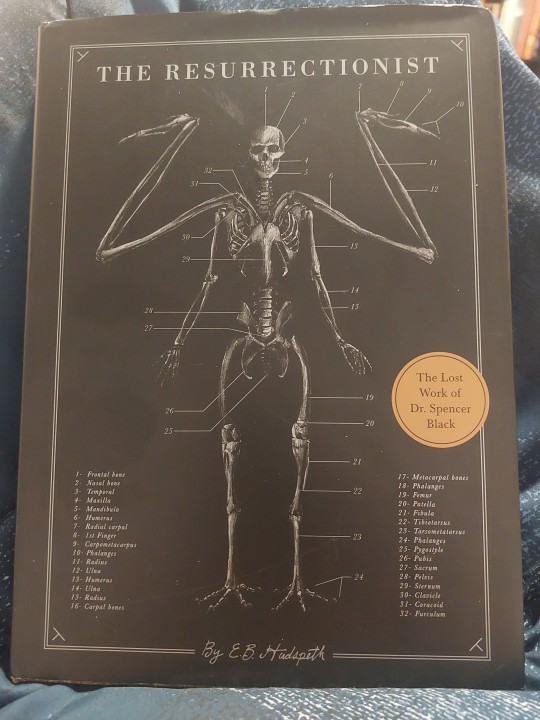
The Resurrectionist by EB Hudspeth, a fantasy field guide full of anatomical illustrations of monsters and cryptids.

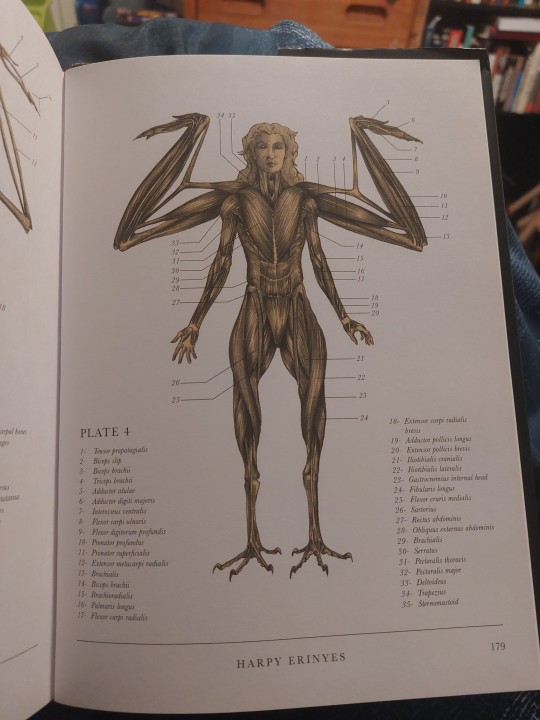
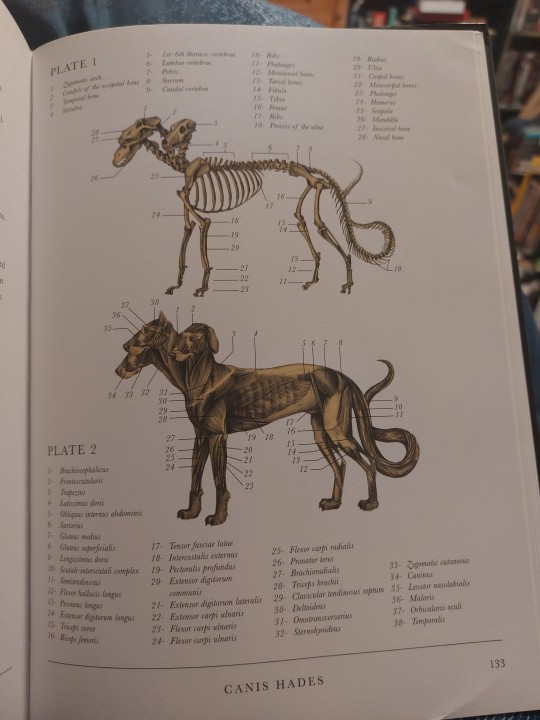

The musculoskeletal systems are fun to look at, but not nearly as in-depth as I would have liked. If you have more than a passing knowledge of taxonomy (or in my case, access to Wikipedia), a lot of the details fall apart under scrutiny
The harpy has four upper limbs connected to one shoulder girdle; it shouldn't have arms, only wings
The sphinx is not classified as a mammal, but is still somehow in the family Felidae with cats (and like the harpy is also drawn with only two girdles despite having six limbs. I will give the author credit for giving the sphinx a keel for the wing muscles to attach to)
It lists the Hindu deity Genesha as a cryptid, which is a no-no.
Cerberus is also explicitly not a mammal, but somehow still a canine (literally in the species Canis with wolves, dogs, and coyotes)
Both mermaids and dragons are listed as members of the order Caudata; the only extant members of Caudata are salamanders, which kinda makes sense for dragons, but not so much for mermaids (also, the author keeps playing it fast and loose with cladistics; both mermaids and dragons are in the same order despite being in different classes, and while dragons are explicitly said to be amphibians, mermaids are given the fictional class mammicthyes, which means mammal-fish. At that point, why not just call mermaids amphibians? Why make up a fake latin hybrid name?)
But what bugs me most of all is the classification of the Minotaur as its own order of mammal when in mythology it is explicitly described as a hybrid of two known species (made possible only by the cruel machinations of the divine, but still)
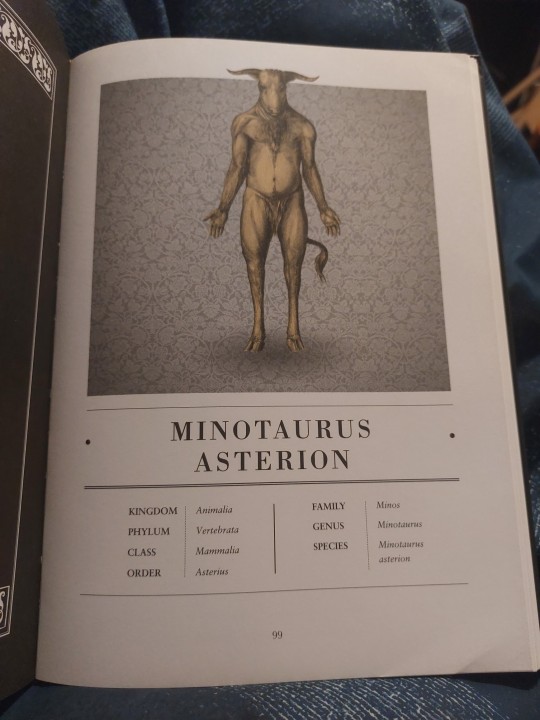
To use actual taxonomical nomenclature, the minotaur's species would be B. taurus × H. sapiens (specifically B. taurus♂ × H. sapiens♀; there are, to my knowledge, no legends of H. sapiens♂ × B. taurus♀). That's how ligers, tigons, mules, zorses, pizzly bears, narlugas, etc., are described.
If I had written this book, I would have leaned more into evolutionary biology. Most land animals have four limbs because they all evolved from boney lobe-finned fish, which split off from the boneless sharks and rays millions of years earlier, so any six-limbed vertebrates would need to be descended from a fictitious category of six-finned fish which would either be an offshoot of boney fish/tetrapods (I guess they'd be hexapods, though that term refers to insect arthropods), OR a precursor to boney and cartilaginous fish that both clades split away from much earlier (it's easier to lose structures than to gain them, so it makes more sense for a six-limbed ancestor to spawn four-limbed descendants than the other way around).
Think about how different elephants are from humans, and humans are from aligators, and aligators are from penguins, and remember that they all evolved from the same ancestor tiktaalik, an amphibious fish that existed some 375 million years ago. Imagine a precursor six-limbed species and how diverse all its descendants would look after 400 million years. Save for the occasional instance of convergent evolution causing two unrelated species to independently evolve similar body plans to fill the same niche, tetrapods and hexapods would look nothing alike. There would be very little recognizable overlap between the two. A six-limbed "pegasus" would not look like a real world horse, and a six-limbed "dragon" would not look reptilian/dinosaur-ish, for much the same reason that giraffes don't look like frogs; they're just too distantly related. Bonless sharks and boney fish and whales/dolphins all have similar looking bodyplans only because their environment requires the same hydrodynamic shape, while terrstrial vertebrates are much more physically diverse.
#biology#anatomy#monsters#cryptids#cryptozoology#book of monsters#evolution#evolutionary biology#evolutionary history#taxonomy#cladistics#science#hard fantasy#hard science fiction#hard science#tetrapod#hexapod
2K notes
·
View notes
Text
Don't shame people for writing or enjoying more grounded settings. People writing speculative fiction that cares about realism in certain aspects isn't stopping you from writing something that doesn't care about realism. "It's fantasy that shouldn't matter" isn't universal, if someone cares about that part of their worldbuilding you don't have a right to say they shouldn't. Just like how somebody talking agaisnt your world for being unrealistic in a place where you don't care about that level of realism sucks, it sucks an equal amount to dismiss someone striving for realism because you'd personally be fine with those aspects being unrealistic.
"Just let people enjoy things" applies to hard science fiction and low fantasy as much as it applies to soft science fiction and high fantasy.
#worldbuilding#writing#writeblr#writers on tumblr#fantasy#writers#196#writerscommunity#fantasy worldbuilding#worldbuilding advice#low fantasy#high fantasy#hard science fiction#hard sci fi#discourse#proship
490 notes
·
View notes
Text
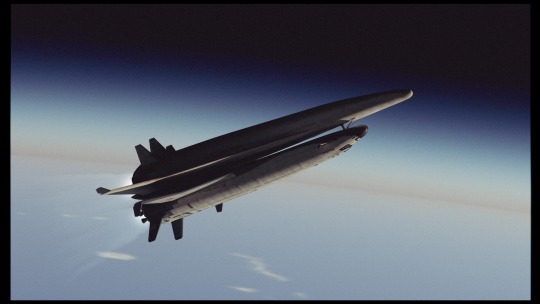

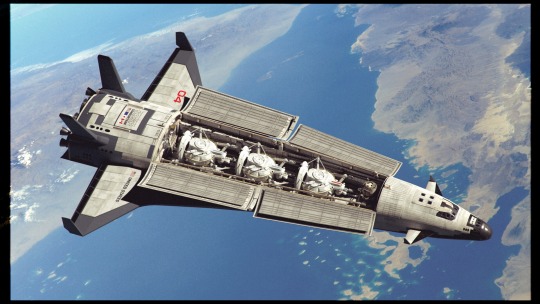
Pacifica Space Shuttle
By Mac Rebisz
126 notes
·
View notes
Text







Timothée Chalamet and Zendaya in Dune: Part Two (2024)
#my gifs#dune part two#denis villeneuve#timothée chalamet#zendaya#rebecca ferguson#javier bardem#dune part 2#dune movie#dune#dune 2021#dune 2024#action movies#scifi#hard science fiction#chani#paul atreides
93 notes
·
View notes
Text
if i had a nickel for every Andy Weir scifi novel im currently aware of which is not part of a series, has a cover depicting a man viewed through the visor of a spacesuit as he stares off into the distance, with the story itself pertaining to him being far from Earth seemingly with no hope of return-


94 notes
·
View notes
Text
A lot of bad "humans are space orcs"/"humanity fuck yeah!" web fanfiction intentionally or unintentionally imitates Niven, but the guy himself was pretty good at avoiding the worst cliches. Every "enemy" species is less inferior to humanity and more a sidegrade with different strengths and weaknesses.
Slavers and Kzin are stronger and faster than humans, but kinda stupid. Fithp are good strategists, but are unprepared for the concept of “revenge.” Moties and Pak are super smart, but can never accomplish anything as a civilization because they’re so warlike.
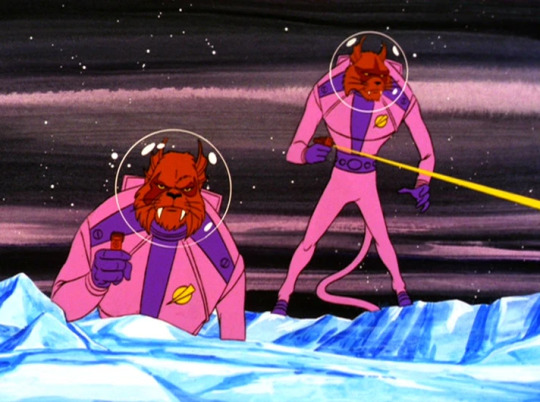
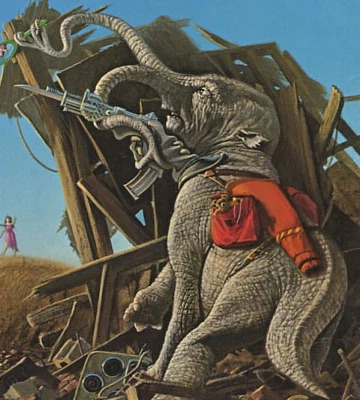


#science fiction#humans are space orcs#hfy#humans are deathworlders#larry niven#hard science fiction#known space#ringworld#man-kzin wars#footfall#the mote in god's eye
39 notes
·
View notes
Text
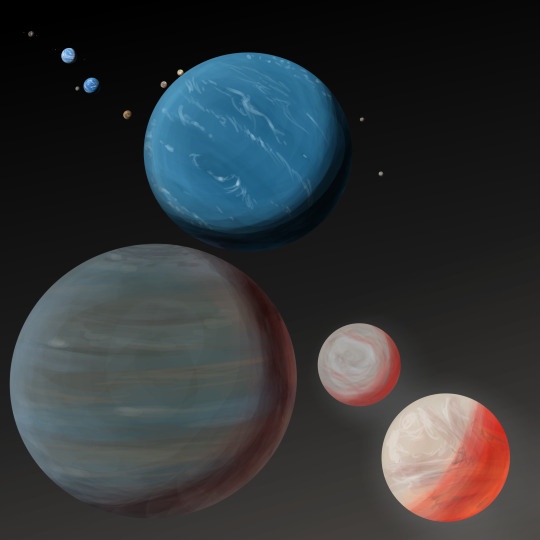


Losar System
Cooking the Solar System from the Inside Out
(yeah lol it does kinda look like it says Loser)
For this system layout, I have taken the Solar System planet's orbital distance in astronomical units, and taken the reciprocal.
The major planets, in order of increasing distance from Los, are Enutpen, Sunaru, Nrutas, Retipuj, Sram, Thrae, Sunev, and Yrucrem.
Read more about them below the cut:

The Losar system formed through a very different mechanism to our solar system. I'm not sure entirely about the specifics, but the arrangement is not dissimilar to the Kepler-90 system, in which 6 super-earth-mass planets are extremely compact and close to their parent star, with a low-mass and a high-mass gas giant at the outer part of the solar system. Perhaps as Retipuj formed, it migrated inward, carrying with it the ice and gas necessary to form the super-earth-mass planetary cores which accreted into Enutpen and Sunaru, or perhaps there was some kind of switcharoo where the Hot Ice Giants started out on more distant orbits, before crossing orbits with Retipuj and then being coralled into lower orbits.
Either way, some kind of migration is necessary, since Enutpen and Sunaru are volatile-rich, and the outer planets are comparatively volatile-poor.
I've excluded Pluto (or "Otulp") and the other dwarf planets, not because I don't like them or think they count as planets, but because I think by the time you're accounting for every large object in the Solar system in the Losar system, it just gets really implausible. also I bet some objects end up inside of the Sun. Plus, this kind of thought experiment is playing the same kind of planetary dynamics game that splitters are playing when they say Pluto's not a planet. Suffice to say, there are definitely lots of interesting small worlds in the Losar system, but they don't have 1:1 analogues with Solar system planets.
There are only five large moons in the entire system. Aside from Retipuj, satellites and rings are not stable around any of the Hot Giants. If satellites were initially formed around the Hot Giants, they would have either crashed into the planets or were ejected into one of the asteroid belts.
The first civilization to arise in the Losar system are the Sunevians, suspiciously great-ape-like feathered aliens who walk on their upper limbs and use their lower limbs as graspers. Sunev is an oceanic world with one large australia-sized landmass and a great number of volcanic islands. The ocean is relatively shallow, with a lot of coral reefs across the planet. The world is kept warm due to an atmosphere with an Earthlike composition but over twice the atmospheric pressure. Its slow retrograde rotation period results in day/night cycles which are more like seasons, and there is plenty of time during the warm nights to peek through the relatively dense cloud cover into the nearly empty sky. Early or late in the night, one might be able to see Thrae and Noom, or Sram, or if they catch it at just the right time, they might see the incredibly bright spectacle of Retipuj or even Nrutas peek out of the treeline, brighter than any planet or star. On a really good sunset across the ocean with clear skies, some observers report seeing additional super-bright red stars next to the red Sun, but these are thought to be some kind of weather phenomenon reflecting sunlight.
In rare moments of clear skies at night, away from light pollution, one might see many faint hazy spectacles. The zodiacal light (meteoroids orbiting beyond Yrucrem) shines as a faint haze across the ecliptic. The milky way too, shines as a glittery patchy cloud across the sky. But sometimes, every few hours, early in the night, there is a bright patch near the sun, brighter than the zodiacal light. A mystery for ages, but this is now known to be the cometary tail of Enutpen. Sunaru's tail is also detectable, but substantially fainter.
Sunaru and Enutpen were the first planets to be discovered, and were detected within a week of one another by early Losar observers. After the invention of the astronomical telescope, a reflector, observers got very bored during the daytime months. That is, until someone figured out a safe way of pointing towards the Sun. At a cadence of 52 and 103 hours, little black dots would march across the Losar disk. 52 hours was also the cadence of the brightening and dimming of the twilight zodiacal light. And suddenly, two brand new planets were discovered!
Millions of years later on the cold ice-age planet Thrae, astronomers would have an easier time with Enutpen and Sunaru, having known them to be planets since antiquity, due to their apparitions during total solar eclipses. Thrae's comparative cloudlessness also helps.
Sunev has three tiny asteroid moons, which was a helpful jumpstart to Sunevian space exploration, providing early wins for all four space programs. But these little asteroids were not truly other worlds, merely refueling outposts on the way to the rest of the Losar system.
Every few years, there would be a perfect alignment between Sunev and the Hot Giants to allow for a grand tour to be completed using only flybys of the gas giants, with minimal propellant expenditure. The first grand tour attempt got no further than Retipuj--contact was lost due to overheating before the probe made its Nrutas flyby. Specially developed solar flyby probes had to be developed that could survive hotter temperatures before the Hot Giants could be properly explored. These probes would resemble the Parker Solar Probe in some ways, albeit with very different scientific instruments designed for planetary science as opposed to Oilehphysics. Nrutas, Sunaru, and Enutpen turned out all to be much less massive than originally thought, having been puffed up to a larger diameter by being cooked by solar radiation. Nrutas, thought to be the king of the planets, turned out to be merely puffing up its crest to appear regal, so to speak.
Retipuj's moons were incredibly interesting. Retipuj turned out to have 8 satellites--four tiny inner asteroid moons, and four large satellite planets. Otsillac, the innermost turned out to be a volcanic world, yellow-brown in color and pitted with dull-red volcanoes, and a thin atmosphere constantly replenished by volcanic plumes. The next three are in a Ecalpal Resonance of 1:2:4. Being both larger than Otsillac (and, in fact, Yrucrem) and in a more eccentric orbit, Edymenag was even more volcanically active, with a molten surface and exposed mantle. The smaller and more distant Aporue and Oi turned out to be less active, with only a few active volcanoes and many extinct ones. Oi was the least active--although the most recent eruptions were only half a million years old, it was practically dead. It was also the only one with a substantial amount of impact craters, and like Thrae's satellite, Noom, there is likely some volatile ices stuck in the permanent darkness of polar craters.
Hot Giant exploration was best appreciated by specialists, but the other outer planets were much more appreciated. Sram was thought to be warm enough to potentially support liquid water, but its atmosphere ended up being 1/20th of the pressure initially expected, the majority of it having been blown away into space by the Losar winds and the Enutpen tail. But Thrae was a sweet spot--it may have had a thinner atmosphere, but that was compensated by being nearer to Los. In addition, a giant impact it sustained billions of years ago lead to it having a powerful magnetic dynamo to survive the onslaught of the Losar and Enutpen winds. Thrae was a habitable biosphere of similar complexity to Sunev's, albeit with deeper oceans and all the alien horrors that comes with the territory.
Even Yrucrem turned out to be a surprise--despite a dull appearance in telescopes, it was found to have cryovolcanoes and pockets of subsurface oceans, which could potentially support a biosphere. It's a dark brown color due to ice having been aged by solar radiation, with white spots and rays spraying out from recent asteroid impacts and cryovolcanic plumes. The small planets of the trans-Yrucrem asteroid belt were a similar treasure trove, although the nearest large trans-Yrucrem planets were a dozen au away, and requiring RTG power sources. Initial flyby probes to the Trans-Yrucrem-Objects required both being capable of surviving the oppressive heat of Los-shine near Retipuj, and the cold of deep deep space, in order to take advantage of Sunev-Thrae-Sunev-Retipuj gravity assists.
The Sunevians never had a chance to discover the deepest secrets of the Losar system. Their planet froze over due to anthropogenic aerosol production intended to reverse anthropogenic carbon emission, civilization fell, and it never recovered.
But millions of years later, perhaps the Thraelings have a chance to discover, whether through direct imaging or through analyzing the weirdly arrayed orbits of certain trans-yrucrem objects, the four Cold Giant planets, and the distant brown dwarf companion of the Losar system...
#Space#Planets#Long Post#Gas Giants#Ice Giants#Hot Jupiter#Hot Saturn#Puffy Jupiter#Solar System#Worldbuilding#Sci Art#Space Art#Planet#Moons#Moon#alternate universe#alternate history#speculative fiction#Science fiction#hard science fiction#digital art#astronomy#space exploration
76 notes
·
View notes
Text
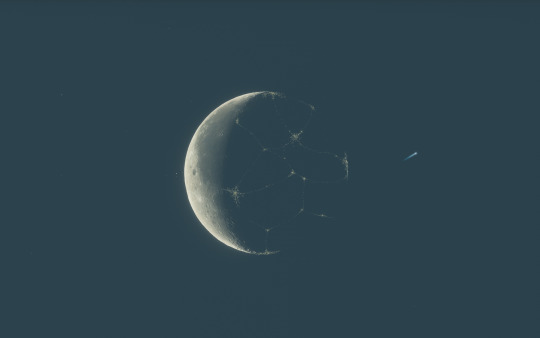
October 4, 2181: The UNSS Skyward Spirit ignites its massively powerful fusion drive in cislunar space, beginning its 24-year round trip to Proxima Centauri. Visible on the Moon are the cities of Byrd, Guǎnghángōng, Apollo City, Tsiolkovskiy, Tycho, and Shackleton, as well as many smaller settlements, all connected by the lunar rail system. Off the sunward limb of the Moon one can also spot the city-station Tsukuyomi in low orbit, with half a dozen vessels in its vicinity. Taken by an unknown photographer at dawn on the west bank of Lake Tanganyika (DRC), using a telescopic lens.
a rare Spy Art appears! photobash of the moment humankind started their very first journey to another sun in my hard science fiction setting Astra Planeta. edited in Paint.NET using a screenshot from Space Engine.
#Astra Planeta#spyglass’ realms#spy arts#worldbuilding#space#space art#futurism#future history#science fiction#hard science fiction#scifi#hard scifi#scifi art#scifi writing#photobash
33 notes
·
View notes
Text
I love you hard science fiction I love you hard fantasy I love you stories that explain exactly what happens and why I love you logical progressions I love you magic treated like science I love you detailed explanations of fantastical situations
#science fiction#sci fi#fantasy#hard science fiction#hard sci fi#hard fantasy#jurassic park#the andromeda strain#the martian#the lord of the rings#lotr#dimension 20#exu calamity#exandria unlimited#exandria calamity#the locked tomb#the locked tomb trilogy#tlt
678 notes
·
View notes
Text
Chapter thirteen of The Brightest Stars, my hard sci-fi bond-esque spy story, is now available for everyone on my Patreon!
This chapter is titled The Cold Equations, and if you like classic sci-fi, you know what that means 😉
#my writing#trans#writers on tumblr#trans writers#tumblr writers#writerblr#fiction#novel#hard science fiction#spy thriller
17 notes
·
View notes
Text
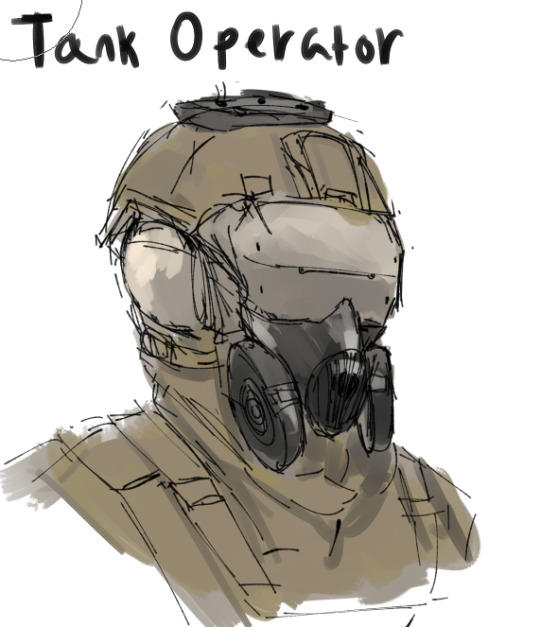


some quick design doodles for my personal TTRPG project
39 notes
·
View notes
Text

The Zero Point universe lacks any true artificial gravity tech; as a result, most starships and space stations have rotating sections to simulate gravity via centrifugal force instead. Seen here is a typical space station, consisting of a rotating habitat ring, housing the station’s residential and commercial spaces, and a non-rotating central hub where visiting ships can dock.
#zero point#space station#spacecraft#sci fi#science fiction#hard science fiction#sci fi art#illustration#art
14 notes
·
View notes
Text
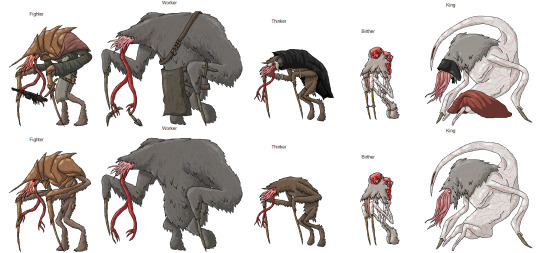
Thinking about this spec evo race I've had for a while. They're very much at the edge of my setting, but I still think they're interesting lil guys. They're aliens that travel by generational ship to set up colonies in other star systems. They're eusocial like bees or ants, but they're not a hive mind, that's just how they naturally reproduce, the workers, fighters and thinkers are all about as intelligent as a human, and the kings and breeders are basically their cattle. While they are intelligent, they don't have the same instincts for things like self-preservation that we do, so they'd gladly die for their hive.
There's a lot of politics between them, humans and two other species. Though since everything is slower than light its politics that are too big and slow for any single faction to really understand, almost like a futuristic version of how homo sapiens interacted with other human species.
What do you guys think of them?
#spec evo#speculative zoology#speculative fiction#speculative biology#speculative evolution#my art#worldbuilding#my worldbuilding#alien#alien species#alien civilization#hard science fiction#hard sci fi#science fiction#scifiart#spec evo art#eldrichcore#eldrich horror#eldritch#hive
81 notes
·
View notes
Text




The Vonnegut
By Seth Pritchard
39 notes
·
View notes
Text


The Bene Gesserit in Dune: Part Two (2024)
#my gifs#dune 2024#dune part two#charlotte rampling#rebecca ferguson#denis villeneuve#hard science fiction#action movies#scifi movies#timothée chalamet#zendaya#dune 2021#dune part 2#dune movie#dune#arrakis#chani
68 notes
·
View notes
Text

Panoptes' cislunar constellation keeps tabs on everything passing near the Homeworld, be it debris or denizen.
(4K available on YouTube)
#i rendered this out in powerpoint btw#worldbuilding#lore#hard science fiction#science fiction#scifi#writing#space#spaceflight#moon#Youtube
22 notes
·
View notes